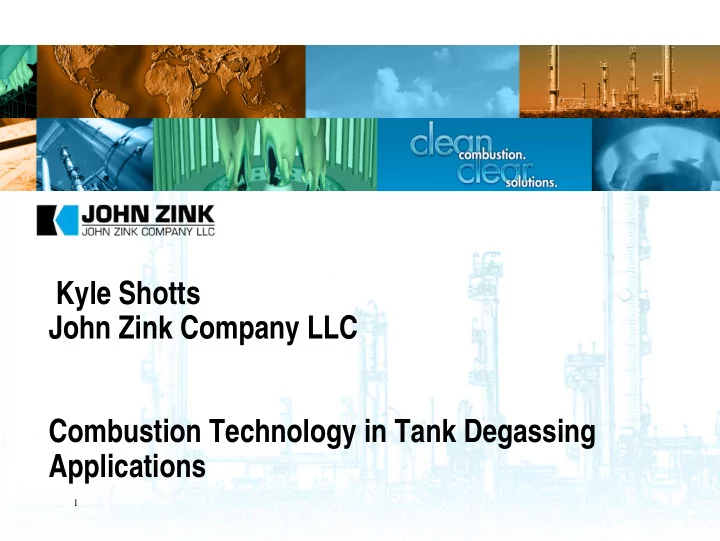

Kyle Shotts John Zink Company LLC Combustion Technology in Tank Degassing Applications 1
2 Fuel Ignition Oxygen Source Combustion Triangle 2006 by John Zink Company, LLC C
3 Basic Combustion Stochiometry C2H6 + O2 CO2 + H2O + Heat Ignition Source 2006 by John Zink Company, LLC C
4 Basic Combustion Stochiometry C2H6 + O2 CO2 + H2O + Heat Ignition Source Air = 21% O2 and 79% N2 2006 by John Zink Company, LLC C
5 Basic Combustion Stochiometry C2H6 + O2 CO2 + H2O + Heat Ignition Source Air = 21% O2 and 79% N2 C2H6 + O2N2 CO2 + H2O + N2 + Heat Ignition Source 2006 by John Zink Company, LLC C
6 Expected VOC Destruction Efficiency Through Combustion Hydrocarbon In - Hydrocarbon Out Hydrocarbon Destruction Efficiency = Hydrocarbon In Typical Hydrocarbon (VOC) Destruction Efficiency = 98%- 99.99% 2006 by John Zink Company, LLC C
Atmosphere N 7 N Air O O Typical Commercial Combustion System N N N N N N N N O O O O Main O O O O Burner N N O O Pilot (Ignition Source) 2006 by John Zink Company, LLC C
8 N N Air O O N N Main O O N N O O Burner N N H H O O N N H C C H O O H H Pilot N N N N O O O O 2006 by John Zink Company, LLC C
9 N N Air O O N N H O O H Main N N N N H Burner O O C N N O O H O O C N N H H O O N N O O Pilot Typically 600 - 900 C 2006 by John Zink Company, LLC C
10 N N N N Air O O O C O H N N H O O H H O C O Main H O Burner H N N Pilot 2006 by John Zink Company, LLC C
Typical Chemical Composition of Gasoline Vapors 11 Auto Ignition Component Vol% Temperature C Air 58.1 ---- Propane 0.6 476 i-Butane 2.9 468 Butene 3.2 414 n-Butane 17.4 427 i-Pentane 7.7 420 Pentene 5.1 272 n-Pentane 2.0 284 Hexane 3.3 247 2006 by John Zink Company, LLC C
12 What Affects Destruction Efficiency? • Air / Gas Mixing • Operating Temperature • Residence Time Air N N H O O H N N N N H O O C N N Main O O H O O C Burner N N H H O O N N O O Pilot 2006 by John Zink Company, LLC C
13 • Smoke Other Considerations: Causes: C C C • Too Little Air Air C • Poor mixing with Air C C C N N C H O O C H C H Main C C N N C H Burner C C O O H H N N N N O O O O Pilot 2006 by John Zink Company, LLC C
• Carbon Monoxide 14 Other Considerations H H • Poor Destruction Efficiency of VOC C C H Causes: H • Too Low Operating Temperature H H Air • Too Little Residence Time C O C O H H H H H C C C H H C H H Main H H H Burner H H O H H H O C C H H H H Pilot 2006 by John Zink Company, LLC C
• 15 Thermal NOx Other Considerations O N O • Result of high temperature Nitrogen cracking N O Causes: • Too High Operating Temperature O N O Air • Typically Not Significant Until N O Temperatures Reach 1300 - 1500 C O O N N N Main N O O Burner N O O Pilot 2006 by John Zink Company, LLC C
16 2006 by John Zink Company, LLC C
17 Typical Combustor in Tank Degassing Fuel Nat Gas or Propane TIC Air TE (Open) (Closed) Typically 600 - 900 C Tank Vapors (High LHV) Pilot 2006 by John Zink Company, LLC C
18 Typical Combustor in Tank Degassing Fuel Nat Gas or Propane TIC Air TE (Closed) (Open) Typically 600 - 900 C Tank Vapors (Low LHV) Pilot 2006 by John Zink Company, LLC C
19 Flammability Limits Upper and Lower Flammability Limits LEL UEL Component Volume % _ Methane 5.0 15.0 Propane 2.1 9.5 Butane 1.8 8.4 Pentane 1.4 8.3 Gasoline 1.4 7.6 2006 by John Zink Company, LLC C
20 2006 by John Zink Company, LLC C
21 2006 by John Zink Company, LLC C
22 2006 by John Zink Company, LLC C
23 2006 by John Zink Company, LLC C
Required Safety Features 24 • Vessel Purge Prior to Pilot Ignition • Instantaneous Pilot Monitor • Anti Flashback Burners • Detonation Arresters • Automatic Shutdown Valves 2006 by John Zink Company, LLC C
25 John Zink Series 2000 Vapor Combustion John Zink Series 2000 Vapor Combustion John Zink Series 2000 Vapor Combustion System System System 2006 by John Zink Company, LLC C
26 Disadvantages of Combustion • No Halogen Containing Hydrocarbons (No CL or F) • Exhaust Contains CO2 and Small Amounts of NOx and CO • Equipment Must be Set in Non-Classified Area • Requires Fuel 2006 by John Zink Company, LLC C
27 Advantages of Combustion • High Rate of Degassing • No Waste Left Behind • Simple Operation • Highly Portable • Reliable • High Rate of VOC Removal • Easily Monitored for Efficiency Without Expensive and Hard to Maintain Monitors 2006 by John Zink Company, LLC C
Recommend
More recommend